The Garage Podcast : S1 EP4
AWS in Automotive with Stefano Marzani, Part 1 of 2
Part 1 of a special two-part episode with guest Stefano Marzani, the WW Tech Lead for Software Defined Vehicles from AWS. We discuss the importance of cloud technology as applied to vehicles.
Listen to audio only version:
Episode Transcript | AWS in Automotive, Part 1
Table of Contents
- Overview
- Introduction
- Meet Stefano Marzani
- Stefano’s role at AWS
- Importance of the cloud to Automotive?
- Five cloud topics across Part 1 and Part 2
- Topic 1: Data in the cloud
- Rich data types from vehicles
- Importance of targeted data capture
- Using data to improve vehicles
- More meaningful data, but less data overall
- Multiple intelligences in vehicles
- Software-defined components
- Examples of AWS customers’ use of data
- Topic 2: Compute in the cloud
- Different compute instance types at AWS
- AWS Graviton
- Summary of Part 1
Overview
JOHN: In today’s episode of The Garage, we’ll present part one in our special two-part series on cloud computing for automotive with our special guest from AWS, Stefano Marzani. In today’s part one episode, we’ll talk about data and compute in the cloud. Let’s go!
Introduction
JOHN: On today’s episode in The Garage, I’m so excited to welcome our special guest from AWS. My good friend, Stefano Marzani. Stefano, welcome to The Garage.
STEFANO: Hi, John. And thank you so much. It’s such a special invite, after three years working together, really a special occasion, right, to think about our passion, talk about them, and, you know, share our experiences. So thank you so much for inviting me.
Meet Stefano Marzani
JOHN: We’re pleased to have you here. And we were thinking about, and we were talking about our common interests. And I think I’ve got at least four really great common interests we have, first beginning with coffee. We love coffee, and we’re very serious about our coffee here at Sonatus.
STEFANO: I noticed that I noticed that right. So it’s one of the best coffee I had here in the Bay Area. So good, good start.
JOHN: Thank you so much. The second thing that we’re mutually passionate about is food, especially Italian food. And as anyone who talks you can tell, you’re from Italy. You’re from Bologna originally.
STEFANO: Correct. Correct, Bologna area.
JOHN: So what interests me about Italian food is not only that it’s great in general, but that all the different regions of Italy have such different food. So I thought I’d start, I’d love you to tell us about what’s the speciality of the region you’re from and tell us the name of the region where Bologna is.
STEFANO: Yeah, region is already extending the concept because, you know, in Italy provinces are really the place where you have different foods. So I’m originally from the province of Reggio Emilia. And if you move 15 kilometers east, or 15 kilometers west, people call the same food with different names. So you can understand how we care about it. But most of the food that you hear here around like prosciutto, lasagna, that kind of stuff comes from that region. So literally, Forbes selected the best region in the world for food a few years ago, but so somebody else saying that so not just us.
JOHN: That’s fantastic. I’m going to have to make a trip to see that especially. I’ve been to Italy, lots and lots of times…
STEFANO: You can be my guest!
JOHN: That’d be great! And you say there’s a fantastic restaurant in the Bay Area that has that type of food.
STEFANO: Yeah, there are several Italian foods, but really specific from the region it’s difficult to find. Not here in the Bay Area. Still looking for it.
JOHN: We were chatting before the episode also that we have a mutual friend: my grad school officemate, is now a professor at the University of Bologna, Luca Benini. Luca is a good friend of mine. He’s from Ferrara originally, which is also in that province. So and I understand, he’s your friend as well.
STEFANO: Yeah, it’s met him many, many, years ago. But yeah, definitely at the beginning of my career, we started to talk about some electronic stuff, as you can imagine, at that time, so I met with him. I think it’s more 20 years ago or something.
JOHN: Fantastic. So, Luca, if you’re watching the show, hats off to you. The third thing we have in common is we both love video and podcasting. Yeah. You’re a host of your own show from AWS, which is incredibly impressive. And so we’re actually so honored to have you as a guest here on our show. Just mention quickly, you’re show and the kind of things you cover, and we’ll put a link to the show in the video.
STEFANO: That’s surely appreciated. It’s called All Things Automotive. And we are about to start filming the third season of it. First one, unfortunately, was remote during COVID. And then we got a season out. It was in studio, it was absolutely a great experience. First time for me doing something like that. I was always joking with my colleagues. It’s kind of a second side job, right? So I because I’m a technical guy, I work on real technical stuff. So doing, you know videos with such level of production or high quality, it’s really been a special occasion for me and huge learning, huge learnings lovely experience.
JOHN: If you’ve not seen the show, it’s incredible. So you will look like an amateur if you see it, I promise you, you look like a professional. We’re so glad to have you.
Stefano’s role at AWS
JOHN: And really the fourth thing and really, which brings us to the topic of today’s episode is the cloud and automotive.
STEFANO: Yes.
JOHN: And you’re so passionate about that. And you have such a unique role at AWS, I’d love you to tell us about your role and what’s your responsibility at AWS.
STEFANO: Of course! So I’m the worldwide tech leader for software-defined vehicles at AWS. So you know, Software Defined Vehicle is this new macro trend in the automotive industry that is really transforming the product, we will talk about that later, I hope, but my role is really a tech strategy role. So trying to understand from customer what they need, and talk internally, bring that internallytalk with our services team, talk with our industry products team, and together find the best solutions for our customers. So from the technical perspective, then I have colleagues taking care of the business of the partnership side. But my role is really focused on finding out right architectures and what the customer, you know, really satisfies them from the technical perspective. And I did that, this is the first year as a tech leader for SDV. Before that, I was for two years the tech leader for ADAS/AV, right so really thinking about this domain and doing the same thing, understanding how the technology is evolving, how we can capture technology and evolution and transform it in service and products for our customers. But the you know, really in the end, the end, you know it very well, because there was where we started our collaboration from that point of view, right.
JOHN: Absolutely.
STEFANO: And in there after last year was really focused on creating SDV architecture for, you know, autonomous driving and datas. So, we did a good job, because at the end, they said, it’s pretty good. So maybe you can do that for all the other workloads in the car, including HMI connected and so on. So yeah, it’s such a such a privilege, I tell you, to work in this context in such a transformative moment for the automotive industry. So I feel I feel blessed in that sense.
JOHN: That’s, that’s right. And we’re going to talk about all of those topics. I think this is going to be a long and very interesting conversation. I’m so looking forward to it.
Importance of the cloud to Automotive?
JOHN: You know, we just had our friend here, our mutual friend, Robert Day from Arm.
STEFANO: There you go!
JOHN: He was in the studio just a little while ago recording as well. And I asked him a question about low power in automotive, because I, when I asked him, I said, you know, many people, I think don’t appreciate the importance of low power in automotive, they say “Ah, a car has a big battery”. But actually, he pointed out how important low power is. And I’d like to ask you a similar question for the cloud. People may generally understand the cloud and how important it is. But I’m not sure everyone necessarily understands why the cloud could be so important for automotive.
STEFANO: There can be a very can be a very long answer to that. But there are several reasons. But I do like the point that you started with. Because low power in terms of cloud means consolidating resources. And we have a huge effort for sustainability. That, at the end, is something very important for mobility, certain mobility sector, at large overall. So and that that’s really, really important, right? So consolidating these resources in data centers that are energy efficient, carbon neutral, we have a very important big objective in being carbon neutral. So that, you know, is a way to use resources in a very conscious way. Let me put it that way. I like that starting point. But of course, there are technical reasons why the cloud is relevant in this space, think about connected vehicles out there. All the vehicles are connected, you know very well, right. And I hope to hear from Sonatus. Right? It’s a dialogue. So I really like to see what Sonatus is doing for that for connecting all this, these vehicles and their experiences. And where are they sending the data? Most of them are sending it to the cloud. Because our service, Amazon S3, is very efficient to store this data have multiple ways to manage data to store data in classes, depending on the usage or the frequency of usage of the data. It has automations if you’re not using this data too much, maybe this goes in a tier, that it takes a little bit to recover the data, but you pay less, right. So you have all this strategy that comes as managed services that make cloud services so appealing for customers, because they don’t have to think about it, right. And they can optimize their IT infrastructure, and focus on what really matters, that is innovating for the products. And especially in this phase in the automotive, you know it very well, the product is changing radically. So there’s no time to waste, right. So and with our managed service, we are helping because we can let the customer focus on what matters for their customers, the people who is buying and experiencing the car. So S3 is just an example. But that can be applied to compute services, machine learning services, and all our services we offer that have similar logic, we managed service as we say we have and we try to avoid customer and we absorb the undifferentiated heavy lifting that our customer have right, repetitive task, we just automate them where possible in the shift to the cloud, or these processes make the life of our customer easier.
JOHN: Thank you for that summary. That’s so interesting.
Five cloud topics across Part 1 and Part 2
JOHN: I was thinking we might discuss the cloud in five aspects today. And it seems to me these are the aspects that are relevant to the automotive market, which is first is data. Second is compute specifically. Third is about prototyping because I think there’s a real aspect of prototyping for vehicles. The fourth is analytics and artificial intelligence/machine learning. And finally, the fifth, which we mentioned earlier, is autonomous and ADAS where think the cloud can offer some specific advantages.
Topic 1: Data in the cloud
JOHN: So let’s start with data first, cars and, you know, vehicles of all kinds are producing more and more data, especially as they’re being connected. So let’s talk about some of the ways that the cars produce data. And some of the things you see are the most interesting examples of how data can be used in the cloud.
STEFANO: Yeah, so first of all, the quantity of data is just, you know, really a lot. That’s, that’s what we are observing. So I’d say that the first trend is optimize the collection of data. So talking about data, how we can reduce or optimize, right, this data logistics, we have several services, of course, to collect data from our basic IoT services and services for data logistics, right? Sometimes the data collected, especially by our autonomous driving customers, it’s so much that you can’t just transfer it to the internet. So we have physical devices called Snowball devices, Snowball edge, that physically, you download this data inside these devices, and you ship the device to AWS in order to upload or download them — the way you see it — to the cloud this data. So data, logistics is a thing. So maybe we can discuss that later. Because it’s really a combination of compute and data, if you’d like right, more and more. So we call it this big loop, that you are very familiar with.
Rich data types from vehicles
STEFANO: Interesting data, what I can tell you a recent trend we see more and more from customer is about videos, right? It’s very important. Think about how rich a modern car is in terms of sensors, you have not just any more like in the past the collection of CAN data, the Controller Area Network data, simple data like speed, position, you know, steering wheel data, or braking status. But more and more we see rich data coming in. So we have video cameras, several video cameras in a car, LiDARs, we start to see regular cars, high volume cars adopting LiDARS…totally new for the market. We have Radars, right, ultrasonic sensors, and so on. So it’s, I’d say that the modern trend, we see collecting this data, and this will generate a new generation of services. Think about the possibility, for example, to observe to through your vehicle’s cameras, what’s going on around the vehicle, on your smartphone, right? Services like this are really, really will change in a way our experience with the vehicle itself, we will see the vehicle more and more a sensor set, if you will. So rich data and use for these different purposes, security, safety, traffic management, traffic logistics, mobility systems as well. And personally, there’s one of them I’m very passionate about, everything ADAS safety related. That’s an easy win. It’s a big win. Because if you look at statistics, still there are a lot of dangerous situations out there that can be mitigated by the use of ADAS now, right. That’s, that’s data that to me has a special weight, if you ask me.
JOHN: Absolutely. And we’re going to definitely spend some time on ADAS and autonomous later, because I think that’s a whole area in and of itself.
STEFANO: Yes.
Importance of targeted data capture
JOHN: But that’s, that’s really interesting, you talk about the different kinds of data. At Sonatus we care very much about data, it’s one of the areas we focus on, we see that the conventional data gathering approaches tend to be quite rudimentary and fixed. And what you tend to see, we believe, is that there’s a need for dynamic adaption of the kinds of data, whether that’s things like vehicle dynamics, for things like tuning t he vehicle, diagnostics, we’re seeing a growing need, as vehicles become more complicated, and you’re seeing recalls, and so on like that, you want to really avoid those problems, and by diagnosing them in the field. And we think fine grained, configurable, data capture can be a really important thing. And that’s one of the reasons where you’re such an important partner to us, because we, that data goes to the cloud, it needs to be acted on, and we’re going to talk about analytics and other kinds of things. But getting the right high-quality, trustworthy data to the cloud, I think is an important foundation. And you’d mentioned also rich data as well. We also see that as well, we believe that by marrying together, for example, vehicle dynamics, that says, well, there was a harsh steering event with let’s say, camera data or Radar data, you might be able to actually do a better job of tuning an algorithm perhaps, than if you had any one of those in isolation. And so merging different data streams together can be, I like to say, “one plus one equals seven”.
Using data to improve vehicles
STEFANO: Absolutely. I totally couldn’t agree more. And this is really in line, by the way with our definition of SDV. You know, we started with this our definition saying yeah, of course it’s SDV is introducing new functions in the vehicle — software functions in the vehicle — when the vehicle is out, right? And that was our definition and speaking with customer realized it’s a little bit more than that, right? They say, Yeah, but, you know, we’re not just there in the cloud. We have a physical product here. So we want to use the data that is generated by the vehicles to improve the physical aspect of the product, its own components, right? Think about the steering system, braking system, how we can generate, you know, start to design the next generation power steering of a vehicle if we collect the data from the majority of the vehicles out there, right. So we modified, we added this section to our definition of SDV. So it’s not just more new functions where the vehicle is out. But taking these insights, right, to design the next generation vehicles in all their dimensions, including the physical ones.
More meaningful data, but less data overall
STEFANO: And there are plenty of examples of that. So totally agree it’s more and more important and the dynamic relation between it’s not just saying, okay, sending down a configuration, collect this data. Now, maybe there’s a special condition we want to detect: if we see that condition, we want to explore a little bit more. And so let’s try to have some more data from some other sensor to see if we can understand better the situation. So this kind of logic are top of mind for our customers. And, again, not just for design purposes, but if you think about it, it’s an optimization of the system. So why acquire collecting all the data and use 10% of that? Maybe we can have more granular ways, more smart ways to connect to collect data. And okay, if you don’t see anything weird or particular, just don’t record, right? If you see a specific situation, give me the 20 seconds, and send it up. So that’s why we can have more data. But overall, less data that we are collecting, because more meaningful data if you will. So not just more data, and that’s it.
JOHN: That’s right, I can kind of call it the needle in the haystack problem where actually, there’s, if you think about it, normally, everything’s working fine. But then there’s this specific region when something really interesting happens. And you’d love really high-resolution data. But you couldn’t capture that high-resolution data all the time, that would be overwhelming. That’s one of the one of the areas we focus on, for example, is to address that. You mentioned also being able to make vehicles better, we were talking with an OEM, a car company, product manager and he was saying, you know, one of the problems we have is once the vehicle leaves our shipment, we don’t have a fine-grained understanding of how the features are being used. So we design in this feature, and we don’t know if anyone ever uses it, and it’s very expensive to put in, maybe we could optimize the cost of the car or spend the resources in another area. And so that’s another area where we can optimize both the OEMs cost and the users experience by giving them the features they care about. And so that kind of thing. Another area that we think is really interesting, and we kind of touched on is: it’s not that there’s one need, there might be a diagnostic need, there might be a future product analysis need, there might be some sort of ADAS, and they may coexist at the same time. And today, that’s not the way it’s typically done. That’s one of the capabilities we’re trying to build into cars. I’m sorry it’s close to our heart, we’re a little passionate about that.
STEFANO: Absolutely, no, no, I share the same passion, by the way. And the totally led by the way we will talk about machine learning and artificial intelligence.
Multiple intelligences in vehicles
STEFANO: But I frequently say to our customers, when I’m talking about automotive nowadays, cars will have multiple intelligences, not just one, you know, it’s not just we’re gonna deploy ADAS and that’s it, as a neural network. But think about Alexa, right, an artificial intelligence that is able to interact with you. And you may have driver monitoring, you have, I think, plenty of artificial intelligence working at the same time on different data source from different parts of the vehicles for different purposes, locally, some of it needs to be sent out, right and sent up to the cloud for analysis, analytics. And to understand what’s going on. I want to provide you though, another point of view, I think it’s very interesting in that, such as to think about the supply chain of the automotive in the value chain.
Software-defined components
STEFANO: I personally think that it’s not just the vehicle that will be software-defined, but the vehicle components will be software-defined, right? If you want to really improve a subsystem of the vehicle, you have in a way to transfer this knowledge to the manufacturer of that component. So that really is, you know, kind of leading again, these value chain through these data pipelines in a way that needs to flow to the supply chain in the value chain of the automotive. And I think this is interesting, because in that way, you really produce superior products, we see that, for example, for battery management, that’s a very, very classical example, right, in electric vehicles.
JOHN: Exactly. That’s, that’s a perfect example we’re hearing a lot about is you have these components, which historically or in existing approaches, don’t maybe have access to share their data or share analytics, but that really need this kind of algorithmic tuning, algorithmic improvements. And so I think that’s something which is a need, which is unmet today.
STEFANO: Yeah, absolutely. Totally agree. So that’s a very interesting part.
Examples of AWS customers’ use of data
JOHN: So speaking about data, then could you give us some examples of some customers that are using your services and the different ways they’re using it?
STEFANO: Absolutely. So for example we have a very good customer reference with BMW, they created this connected data lake. And they presented it in one of the episodes of All Things Automotive, so it’s online. But even more, there are very technical, deep analysis in one of our previous re:Invent conferences, it’s our annual conference for developers. Their case is so interesting because essentially, you can really see the effort they did to aggregate various sources of data in this connected data lake. And then this data lake serves the entire organization in all its parts. That’s their effort, right? And it’s absolutely great, because you know, that you have this reference, and the data is just used and can be used by IT, R&R departments, wherever needed. So I think this is great. It’s greater if combined with cloud technology, API’s, right, application programming interfaces, clear interfaces, microservices, and that gives the capability for organization to build the application that uses data quickly, right, that’s a very important objective nowadays.
JOHN: A single source of truth, and a common framework that people can base on, it’s really powerful. And this data lake is an important idea. And we’re happy to be part of that, and happy to be sending data to that.
STEFANO: Yeah, and I think you’re doing absolutely a good job in organizing your data, not just, let’s say the mechanism, you transfer data, right. But in the tools I saw and in the console in the various interfaces, you’re proposing customer to work with this data to create automation. So it’s really an important aspect, right. So not think just a specific thing. But this organization or big organization, complex organization. So agility is implemented really in the capability to offer specific services, right? But the data is the truth. So that needs to be consolidated in a proper way.
JOHN: Well, that’s quite a long discussion about data. And perhaps we can have a whole episode on data.
Topic 2: Compute in the cloud
JOHN: But let’s move to the next topic, which is compute. And cloud computing is perhaps very famous, people understand that cloud has incredible compute capabilities. So I’d love it if you could give us an overview of some of the capabilities you have, and especially those that may be applied to the automotive market.
STEFANO: Absolutely I’m more than happy to do so because that’s a one of the, let’s say, big assets that we have, asset that we have in AWS is the variety of compute options. Compute options, that by the way, people can use on demand, right. So that’s a very important thing, because, you know, automotive, it’s really, it’s not just a, you know, a consumption that is always a stable. No, maybe you have to do a simulation exercise, and that will spike up the consumption of compute resources. But the day after you’re done, you have zero consumption. So that’s, that’s a basic issue that we see with some customers that have their own data centers that they already paid for that, right, while the compute offering that we have is on demand. So you need it, you just pay for it, you don’t need it, you don’t pay for it. So that’s a big, big part, I think in being flexible, in being elastic in the usage of resources.
Different compute instance types at AWS
STEFANO: So and that’s where variety is very important. We have several instances, as we call them, that is these compute resources. EC2 instances, Amazon EC2 instances, elastic compute, right? So that’s the origin of the “EC.” And this is a very important part because you have Intel instances, Arm instances, Xilinx instances, so Xilinx FPGA instances, and so on. And if you look at each class of these instance, you have instances that have more memory, more compute power, they have GPUs, or they have special features, more bandwidth, in terms of networking, according to really to adapt to this specific compute need. And this is very important, because we discussed about it, you have all this data coming in…what do you do? You want to have machine learning, for example, training, using this data, that you have P instances, for example. And this is accelerated compute specific to train data. In there as well, we have some chips that we developed called Trainium, right. So that is our own produced chip that is able to train this machine learning networks using the data that has been collected. In let’s say, when you did the training, you want to you want to exercise the model. So we have Inferentia that is another own-built chip that is specialized in doing this work, right. But again, apart our own offering, it’s really important to provide this variety.. we have Mac instances, for example, right? Because if you are an Apple developer, and you want to really produce this development and pipeline, development pipeline at scale, you can use Mac instances and scale them out. So, and we really have solid data about the fact that you really need this granularity. When you adopt the compute, the compute choice where you have that. For example, here we have an example, again, from re:Invent. Continental, explained how adopting the cloud in this simulation exercise to the CAEDGE platform in this case, really, significantly, significantly shorten the time that they were using to train specifically this functionality. So we have more and more data points that support this kind of cloud adoption in terms of compute.
AWS Graviton
JOHN: Well, talking of specialized instances, we have to talk about Graviton. Can you tell us a little bit about that?
STEFANO: Yeah, of course, we need to, we need to because we started our collaboration, right to working on these Arm technologies. So absolutely. So it’s our own processor developed by our Annapurna labs, that is, you know, the, our specialized business unit, if you will, that is producing all this silicon innovation, so including Graviton, Trainium, Inferentium and so on. And it’s an Arm-based chip, it’s a CPU with 64 Arm cores, Armv8, in the cloud. And when it’s been released, it was the first Arm chip in cloud systems adopted at scale. And it’s very important for several reasons. At the beginning, it was really for a power/performance. And we discussed how important it is the sustainability aspect, in adopting the right compute options, right. But more and more, we discovered that Arm is a technology, is an architecture frequently adopted in vehicles by our customers. So we said maybe we can do a little bit more with that, right? And maybe we can discuss about that.
Summary of Part 1
JOHN: Thanks, Stefano, I really appreciate that summary of compute in the cloud. So this concludes part one of our special two-part series with Stefano Marzani from AWS. In today’s episode, we talked all about cloud computing for automotive, particularly about data and compute. In part two of our conversation, we’ll continue and talk about prototyping with the cloud data analytics and AI and finally ADAS and autonomous driving. We hope you will take a look at part two, which we’ll publish soon. Thank you for joining us, and we look forward to seeing you again in another episode of The Garage.
Recent episodes
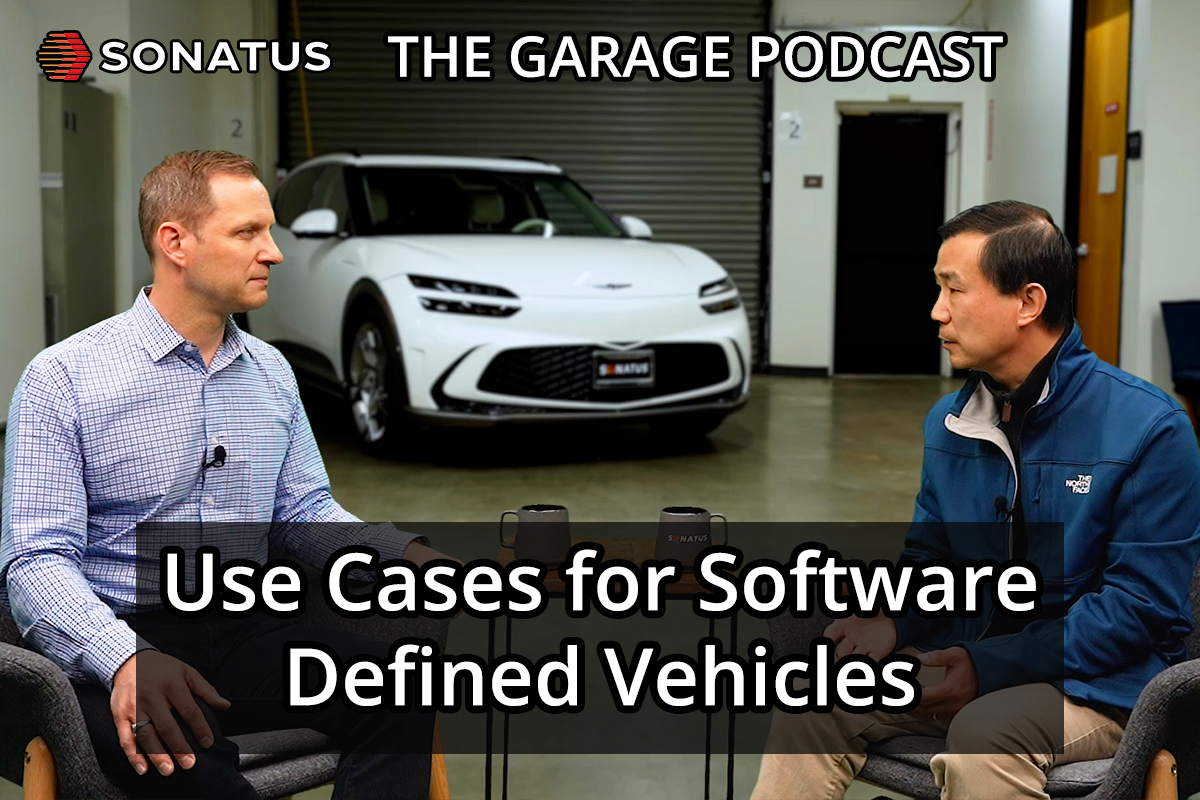
The Garage Podcast
Use Cases for Software Defined Vehicles
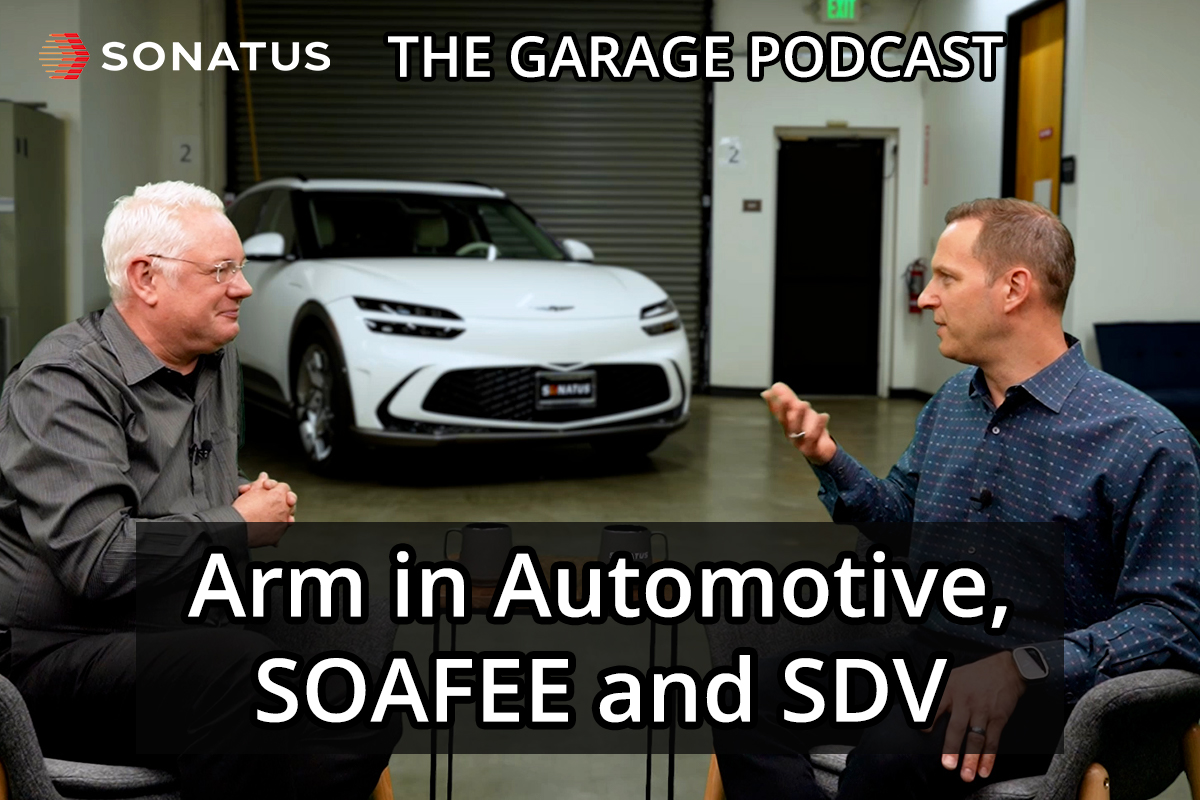
The Garage Podcast
Arm in Automotive, SOAFEE and SDV
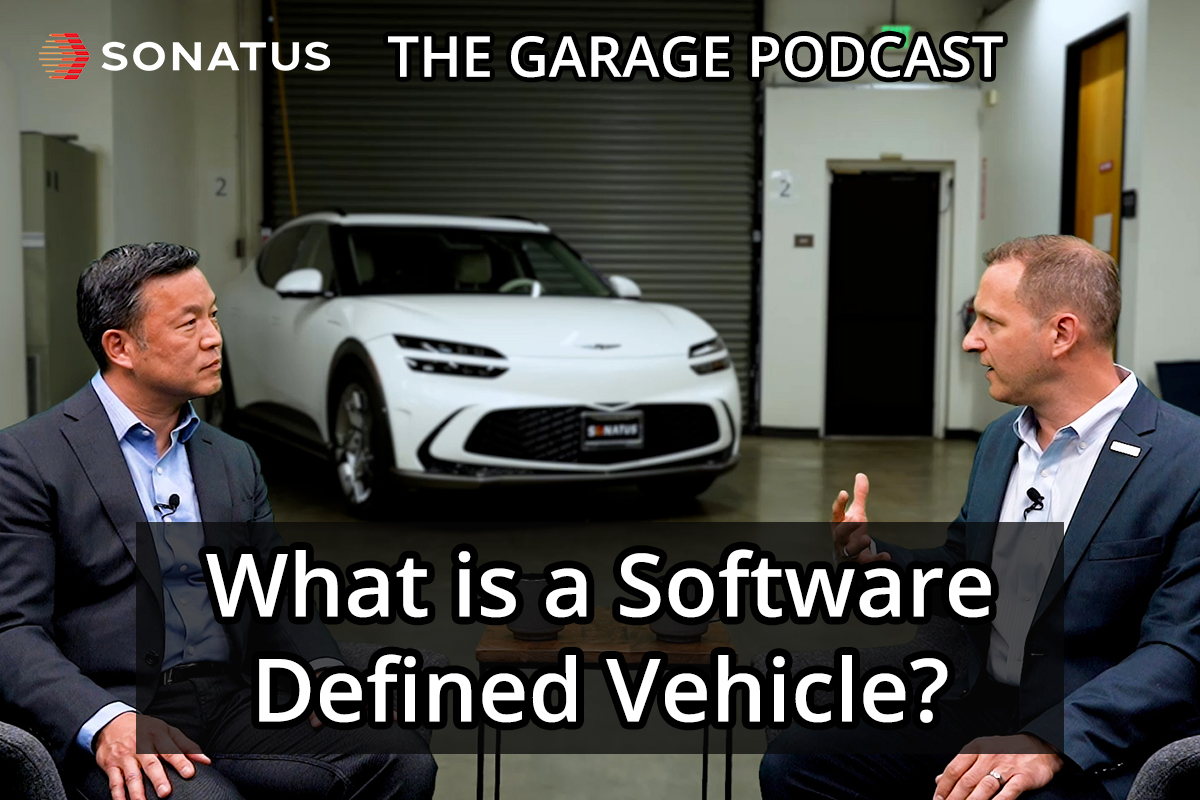
The Garage Podcast
What is a Software Defined Vehicle?
Related resources
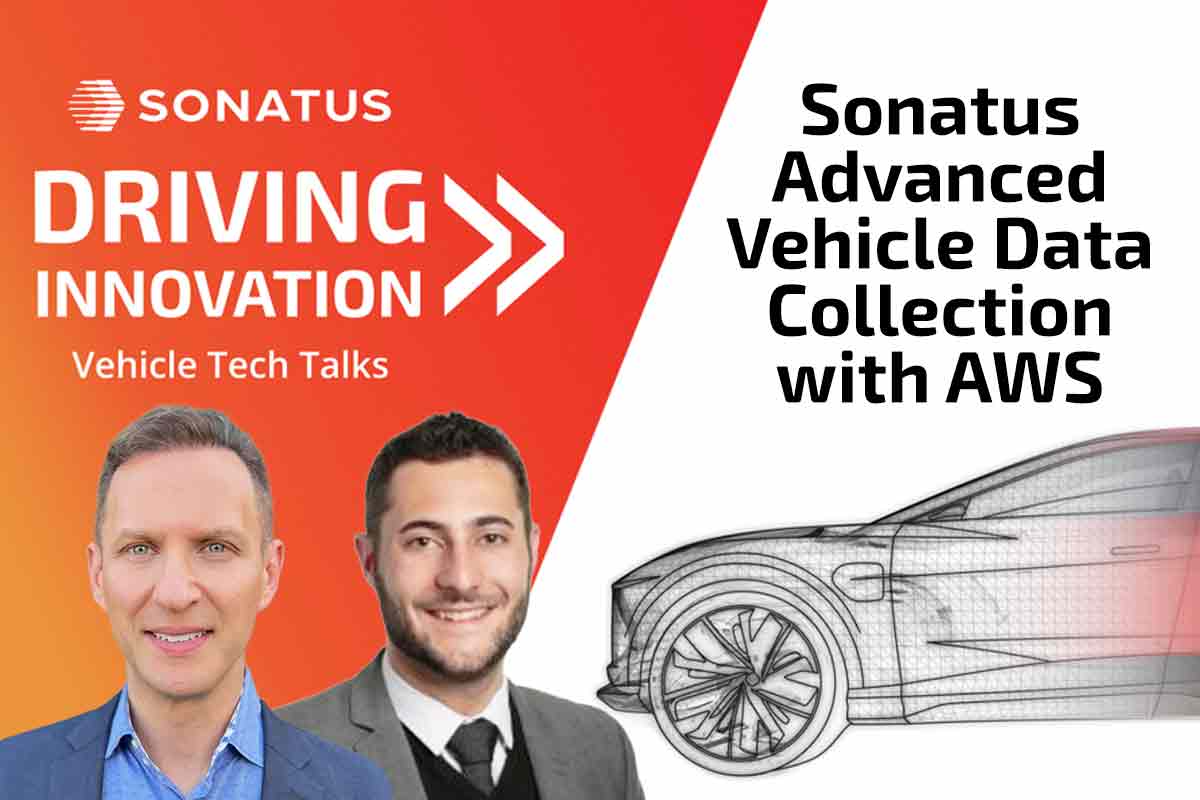
Sonatus Advanced Vehicle Data Collection with AWS
Dr. John Heinlein, CMO at Sonatus, and Michael Garcia, Principal Product Solutions Architect at AWS, discuss and demonstrate the tight integration of Sonatus’ real-time data collection platform with AWS for dynamic data enhancement, enabling OEM and downstream services. Recorded at CES 2024 at the AWS Theater.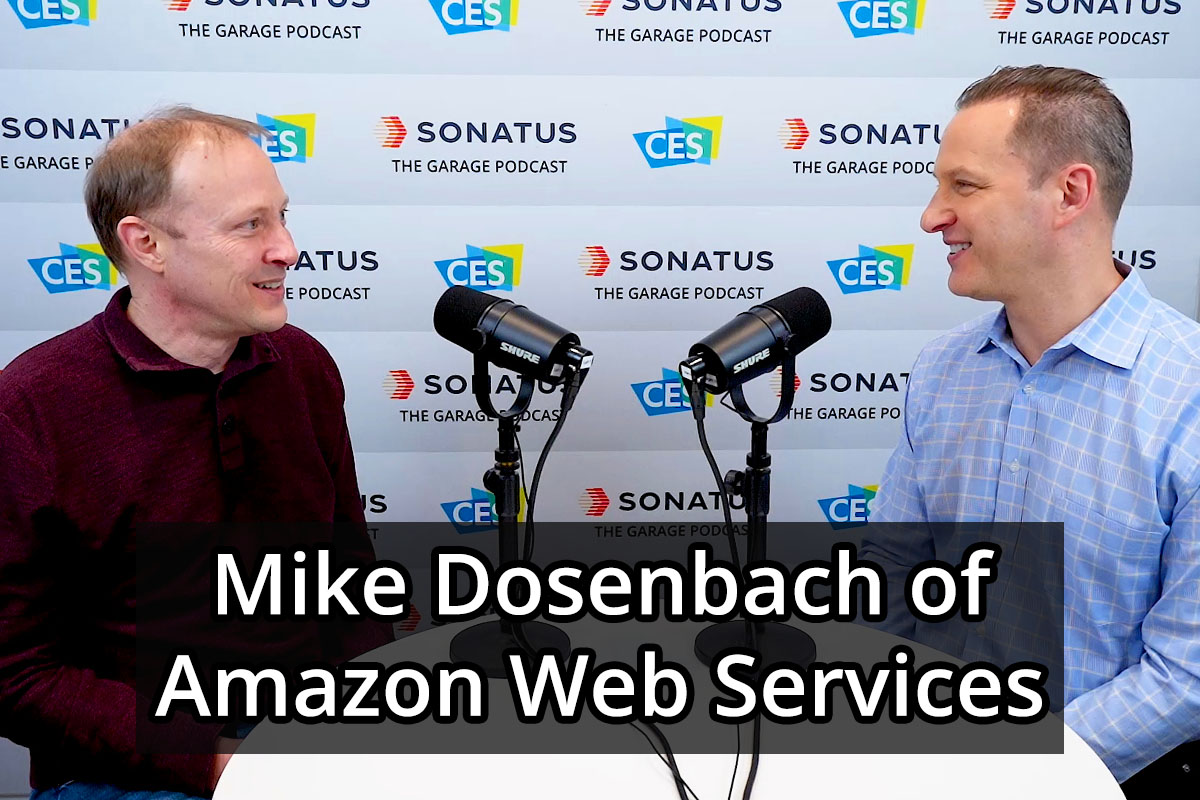
Mike Dosenbach of AWS
Mike Dosenbach, Director of SW Development, Auto Industry Products, AWS discusses the evolution of AWS’s engagement with partners, prototyping in the cloud, machine learning, OTA Updates, the importance of data and much more. Recorded live at CES 2024.